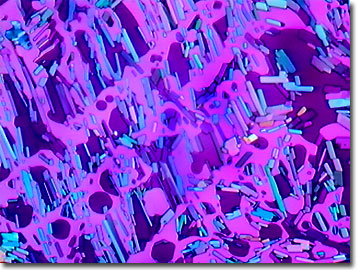Polarized Light Digital Image Gallery
Gamma-Endorphin
Pleasant memories, such as that first birthday party with your friends, or that trip to Yellowstone National Park, and even bad memories, are linked to the autonomic nervous system and the brain stem. Endorphins, a class of neurohormones, act by modifying the way in which nerve cells respond to transmitters and are associated with feelings of pain and pleasure.

View a second image of gamma-endorphin.
Early in the 1970s, several small peptides were isolated that appeared to possess natural analgesic properties, and these were collectively termed enkephalins and endorphins. The modification of neural transmissions by these biochemicals now appears to be responsible for the insensitivity to pain that is experienced by individuals under conditions of great stress or shock.
The effectiveness of analgesic opiate derivatives such as opium, morphine, and heroin is an accidental side effect that derives from the ability of these substances to bind to neurohormone receptors despite their very different structure. Four distinct groups of endorphins have been identified to date. They have been termed: alpha-endorphin, a polypeptide with 16 residues or amino acids; beta-endorphin, a polypeptide with 31 residues; gamma-endorphin, a polypeptide with 17 residues; and sigma-endorphin, a polypeptide with 27 residues. The name endorphin, coined by Choh Li of the University of California at Berkeley, refers to "morphine within", and was given to the endogenous morphine-like peptides that also originate from the pituitary hormone.
Experiments with mice in anaphylactic shock, due to allergic reactions, show significantly improved survival rates with an injection of gamma-endorphin, but exacerbation of the shock condition when beta-endorphin is injected. Endorphin research suggests a link between the emotional state of well-being and the immune system's health. Neurotransmitters such as gamma-endorphin are flooded into the bloodstream during stressful, as well as good times, and can be felt physically as a queasy or nervous feeling in the stomach (explaining the so-called "butterflies" and the expression a "gut feeling"). The placebo effect is also attributed to endorphin and enkephalin releases, explaining the emotional component of receiving a sugar pill. Massage and hydrotherapy help release endorphins and enkephalins.
Contributing Authors
Omar Alvarado, Thomas J. Fellers and Michael W. Davidson - National High Magnetic Field Laboratory, 1800 East Paul Dirac Dr., The Florida State University, Tallahassee, Florida, 32310.
BACK TO THE POLARIZED LIGHT IMAGE GALLERY
BACK TO THE DIGITAL IMAGE GALLERIES
Questions or comments? Send us an email.
© 1995-2025 by Michael W. Davidson and The Florida State University. All Rights Reserved. No images, graphics, software, scripts, or applets may be reproduced or used in any manner without permission from the copyright holders. Use of this website means you agree to all of the Legal Terms and Conditions set forth by the owners.
This website is maintained by our
Graphics & Web Programming Team
in collaboration with Optical Microscopy at the
National High Magnetic Field Laboratory.
Last Modification Friday, Nov 13, 2015 at 01:19 PM
Access Count Since September 17, 2002: 13425
Visit the website of our partner in introductory microscopy education:
|
|
